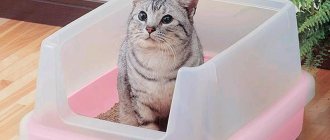General rules of training
There are several tips with which the training of British kittens will be more successful and the kitten will quickly learn to defecate in the designated place:
- Temporarily restrict the animal's movement around the house. The cat must be near the tray at all times, under the supervision of the owner, so that he can react in time.
- Immediately after eating or sleeping, the fold-eared kitten is put into the toilet. And also bring it to him once every couple of hours so that the cat remembers the place.
- If the kitten does not scoop up the litter, then you can help him a little. To do this, you need to carefully take his paws and make a couple of raking movements.
- The smell of urine will attract the cat to the toilet. A paper napkin is suitable, which is blotted at the site of bowel movement and placed in the chosen place.
- As soon as the animal begins to sit down, it should be transferred to the tray. After every successful trip to the toilet, the Scotsman must be praised.
British cats are especially susceptible to punishment and affection. You need to remain calm and have a positive attitude, because a one-month-old kitty can pee anywhere unknowingly. Therefore, we must not forget to praise the pet after each successful trip to the litter box. Timely affection is the key to successful learning.
Possible problems
Options for teaching a Scottish kitten to go to the litter box are described above. However, it also happens that the owner has tried all the methods, but the pet categorically refuses to visit the “thoughtful corner.” Let's consider the possible reasons for this behavior and methods for eliminating them:
- Plastic smell from the tray. A person is not able to catch it, the animal reacts very sensitively. On cat lovers' forums, you can often find posts about how your pet runs away from the litter box like it's on fire. Especially when the tank is cheap and made in China. What should the owner do in such a case? How to train a Scottish kitten to use the litter box? Wash the tank with hot water and soap several times, rinse and let dry. If this method does not help, then you will have to change the cat litter.
- Bad filler, the kitten prefers the more familiar one. The owner thinks that sawdust for the cat litter box is a decent option. It's cheap, the consumption is small, it absorbs the smell - what else do you need? It turns out that the purebred pet has his own view on this issue. Living with a breeder, he got used to stony litter, sand or silica gel. It is useless to convince your pet, because then fragrant piles will be found in places that are completely unsuitable for these purposes. It’s easier to change the filler and forget about the problem.
- How to train a Scottish kitten to use a litter box if the animal does not like its location. There are also whims when a representative of the breed chooses another corner to suit his needs, ignoring the tank with filler. The problem can be easily solved if the tray is moved to the selected location.
When should you train?
Often the issue of toileting for newborn kittens is not urgent, since adult cats solve it by licking their babies. This period lasts three to four weeks. Once the fold-eared kitten reaches the age of one month, he himself begins to look for ways to find a place for himself. Then the pet feels the urge to walk and explore the house. This is the time to start learning. Of course, growing kids try to copy the British cat-mother, but sometimes they fail to reach their destination.
Don't put off teaching your little one. By two months, the Briton should clearly understand where he can relieve himself and where he cannot. The owner needs to be patient, because it is much easier to spend one month on training than to then suffer with a disobedient animal for many years.
Tray selection
It should be taken seriously, because a huge variety of cat litter and accessories are sold. But don’t forget that when choosing a tray for a little Briton, you need to pay attention to some points. So, for example, a wide tray with sides 5-8 cm high is suitable for a baby. This way, the pet can climb into it and get out without difficulty. But for older cats, litter boxes with higher sides are suitable.
Filler selection
Pet stores offer a large selection of accessories for cat litter; the main thing here is not to get lost in the assortment of products and choose the right one. To choose the right one, you initially need to focus on the cat’s habits, and then make a smooth transition to a more convenient or economical option. Fillers are:
- woody;
- corn;
- clay;
- zeolite;
- silica gel.
The choice of filler is an individual process, in which both the owner and the cat take part. To begin with, you can try out different options and choose the one that you like the most. But, we should not forget that keeping the tray clean is not just a matter of filler. It is unlikely that a cat will like a wet toilet, and, most likely, it will prefer to choose another, more attractive place.
Where should I put the tray?
The location of the cat litter box matters a lot for the success of training. It doesn’t matter whether it’s a Scottish Straight, a bobtail or any other breed - the kitten will not recognize the toilet if something is constantly making noise, knocking or rustling next to it. Most likely, the baby will get scared and run away to somewhere quieter. Therefore, the owners choose a toilet, bathroom or corridor as a place for the tray. In such places, noises and smells will not disturb the animal much.
Selecting a tray and filler
This subsection is short but informative. It will be useful for those who are getting a kitten for the first time.
When purchasing a tray, you should pay attention to tanks with high sides. They are good because the filler does not scatter in all directions when the pet carefully buries its waste. An excellent option would be a closed tray made in the shape of a house. These cat litter boxes are equipped with a special door so that your pet feels comfortable while in them. At first, when the kitten is small, the door can be removed.
As for the filler, many owners of “Scots” actively use silica gel. They absorb liquid well, forming small lumps that are convenient for cleaning. The package is enough for a month if you keep one cat.
Frequent difficulties
Raising a British pet is not easy, especially if a person is experiencing it for the first time. There are a number of difficulties that owners of luxury pets often face. It happens that a stubborn cat has chosen another place for his toilet and flatly refuses to relieve his needs in the tray. In this case, there are two options to solve the problem. Firstly, the owner can make concessions: put the tray in a favorite place. But if such a rearrangement is impossible, then block access to this place for the cat. It happens that the cat simply does not like this tray. He may remind her of something unpleasant. Then only buying a new toilet can help. If this applies specifically to the filler, then it is worth replacing it.
How to choose the right tray
Helpful tips to help you choose the right tray. You shouldn’t buy a litter box that fits your pet’s current size, because cats grow very quickly.
Often the choice of container depends on the use of the filler. Various bulk filler options are suitable for a perforated tray. Products with grids help keep the animal’s paws clean.
You should not buy trays that are too light and easy to turn over. In the video you can see different options for containers.
You can find out that your pet doesn’t like the litter box if he goes somewhere else. The simplest option is a plastic tray with sides . This option is suitable for teaching kittens to walk in a certain place in a large area. The product has a low cost, so it is easy to replace if damaged. There are models with high sides that bend inside the tray. In this case, the filler will not crumble outward. You can also choose a container with a mesh, which is suitable for training a pet at 1 month or 2 months .
In this case, the filler is poured into a tray and placed under the grate.
How to stop shitting around the apartment?
The British favorite begins to play dirty tricks out of a feeling of discontent or revenge. First you need to find the root of the problem. So, if a cat has become accustomed to pooping in a corner or on the bed, then most likely the pet does not like the tray or litter. Replacing these two components will solve the problem. Lavender and lemon oil will also help you stop walking on furniture. It is recommended to apply a couple of drops to the headboard and backs of sofas or beds, and the pungent smell will scare cats away from the wrong place.
When a pet refuses to go to the toilet, but every time tries to find a secluded corner and hide its “goods” far away, it means that it is frightened by noises or other people’s looks at the litter box. Purchasing a toilet with a roof, in the form of a house, will be a good option. This behavior is also provoked by a lack of attention from the owner. You need to regularly play and communicate with your pet. And if he goes to the wrong place, you can scold the animal, but not beat him. Otherwise, his motives will be revenge.
Source
Cats are very clean animals. At the kitten nursery, we begin to accustom them to the litter box from the moment of complementary feeding, i.e. from 3-4 weeks. But when a kitten gets into a new space, he gets lost and cannot always choose the right place for the toilet. Therefore, you will have to spend some time teaching your baby where in your apartment he has a designated place for a litter box.
As soon as you notice that the kitten begins to behave restlessly, squeak, and look for a secluded place, take it to the tray. The kitten's litter box should be placed in a quiet place, not in the aisle, so that the kitten is comfortable and nothing distracts it from “important” matters. Usually, in our house, kittens going to the toilet are so rehearsed that our established habit of going to the toilet does not fail anyone, unless the owner himself disturbs and confuses his new pet.
Therefore, when a kitten arrives at a new home, it behaves as it would at home (when adopted at home).
Place the tray within the kitten’s field of vision, pour filler into the tray, and for complete comfort, allow him to dig in it (the top mesh cover should be temporarily removed for about 1-2 months).
Do not place the tray and bowls next to each other! If the kitten is still confused and goes in the wrong place, wet a napkin in urine and put it in a tray with filler. In general, the kitten needs to be shown as often as possible that there is a tray in the room. Later, you will move the tray to its designated permanent location. It is necessary to toilet train kittens from their first step. It is necessary to fence off a small space near the nest and place a tray without a grid with wood filler made from pine sawdust or buckwheat husks. Kittens, like all children, tend to learn everything new and previously unknown. As soon as you dig a little into the litter with your own hand, the kittens immediately begin to dig themselves. And then the instinct inherent in nature itself kicks in - if you dig a hole, then you need to pee there! Curiosity and the desire to do the same as the sisters - cats, cats - brothers do their thing - all the kittens begin to do their business in the tray. It is better not to remove the fence for 2 weeks, because... you need to strengthen the skill of going to the toilet in the litter box, because children are forgetful, and even if the kitten gets lost in the wilds of the apartment and wants to go to the toilet, it will not look for it, but will do everything somewhere not “there”.
To prevent this from happening, make sure the kittens learn their lesson well.
This is advice for those who do not know how to train several kittens at once, 5 or more - you must admit that it is not easy to control and educate them all. For those who take one kitten into their home, it is enough for him to reduce the space where the toilet, food and house or bed for the kitten should be located as far as possible from each other in a small space, so that there is no failure with associations in the baby’s head . When you buy a kitten, don’t forget to immediately buy a potty and the food that kittens eat in the nursery on the same day. A self-respecting nursery gives you a memo that contains all the details of what, how much, where and how! Because a purebred Scottish or British kitten must be kept in accordance with breed standards.
Some people teach kittens to go to a tray without filler, on a grid.
But! Without filler, the smell will spread throughout the apartment, and the cat will not go into the dirty tray if you did not have time to clean everything right away, but will go and do all its “dirty deeds” either next to the tray or somewhere else. What difference does it make to a cat? There’s nothing to dig anyway, whether it’s in the tray, under the door, or behind the sofa. If we are talking about the cost of the filler, I can recommend the filler “My Beast”, “Zoonik”, 50-80 rubles each, and other wood fillers are even available by weight.
Wood filler is produced in different packages of 4.5 kg - in yellow, green and red bags; pet stores also have wood fillers by weight. Everyone is good. Can be purchased at pet warehouses, pet stores, Mr. Auchan, etc. where there is a large selection of pet products. Wood filler lasts much longer than clumping clay filler.
Wood filler, when applied, does not smell at all and there are no traces, but clumping filler leaves clay-“cement” traces on the floor and furniture; the odor lasts worse. Tested: clumping cat litter is carried by the paws of a cat or kitten throughout the apartment, while the wood litter remains in the toilet area! The effect is amazing. No smell. Change the filler about once a week.
Source: www.mmcat.ru
Similar articles:
Random facts from the life of cats and dogs
Some people are afraid of cats, and this is not explained by ancient beliefs in the witchcraft abilities of animals, but by ordinary... phobia! In the presence of cats, such people sit motionless, fearing that otherwise this terrible beast will notice them. And this is exactly what the cat is interested in: she happily climbs into the arms of a motionless person! According to rumors, Napoleon Bonoparte himself suffered from such a phobia. - facts about cats
When does a Scottish kitten begin to go to the toilet on its own?
While the kittens are newborns, all toilet issues are decided by their mother. They go about their little ones on their own, and the cat also helps them go about the big ones: she licks the anus area of her babies with her tongue to stimulate defecation, after which she washes their butts. But these are the first weeks. Some kittens are already trying out the tray before they are a month old, while others still don’t understand what’s what. Starting from a month, cats already move around the apartment over certain distances and can pee somewhere without permission. Although from birth they already see that their mother goes to the litter box, and ideally they themselves try to imitate her. However, if the seals are somewhere far away at the moment when the urge occurs, they will not be able to tolerate it (unlike adult cats) and will make a puddle. By 2-2.5 months, cats should already know their potty. It is not recommended to take them away from their mother before this period, including in order not to suffer from toilet problems.
There are times when a kitten, for reasons known only to him, has chosen a certain place and only goes there. For example, my cat, according to the breeder, has been somewhat capricious since childhood and did not want to accept the common tray. Perhaps precisely because it is general, and she wanted an individual one, after all, she is a princess. And the cat found a suitable place in the kitchen, and the brothers and sisters also took a liking to it. For this they were beaten with a broom and scolded. And although I personally am not a supporter of harsh measures, I am still grateful to the breeder who taught the cat that peeing anywhere is bad. Therefore, when the cat made a puddle at our house on the first day, because... she couldn’t find the tray, it was clear from her behavior that she was embarrassed and didn’t want to allow anything like this to happen, but nature forced her. This only happened once.
Installing the tray in a permanent place
Just as described above, you can train a Scottish kitten to use a litter box at 1.5 months. This method is universal, suitable for animals under 3 months of age.
The pet is getting older and has settled into the apartment perfectly. It's time to move the tray into the toilet room and show the four-legged prankster where he now needs to go about his “business”.
The place for the tray is chosen in such a way that the kitten does not have to look for it for a long time. Due to his age, the baby is not always able to control his needs. You can’t scold him for this, just like you can’t rub your nose into the misunderstanding on the floor. The baby will not understand what he has done wrong, he will get scared and stop trusting the owner.
If the baby does not make it to the tray, his excrement is collected using toilet paper and taken to the right place. After putting the scented paper in the tray, the kitten is placed there too. The new location of the tray will be remembered by the pet, he will begin to rush there, as soon as he feels the urge of the body to do this or that thing.
Preparing to solve a problem
Whether your future pet is toilet trained or not, first of all, when your family plans to purchase a kitten, you need to buy a good litter box for it. The ideal option is a house tray. True, the door will have to be removed from it at least for the first time, because... it can become an insurmountable obstacle for a small cat. The litter box helps the cat feel safer while doing her business. Plus, the roof will protect you from accidental splashes of water and similar troubles.
Also, if we talk about the ideal case, there should be filler in the tray. Kittens love clay the most, because... it reminds them of the natural environment where they should bury their deeds. Although the taste and color... Some, for example, love silica gel because it shines. And some people like woody ones because their cat mother used them.
Also find out from the breeder whether the cat family had litter and whether your kitten liked it. If yes, buy the same one. And experienced cat breeders advise asking the breeder for a handful of used litter to pour into your litter box - this will create a smell that will indicate to the animal the purpose of the tray. In our case, it was not possible to do such a trick, because the breeder used newsprint. Therefore, we solved the issue with the smell for the tray differently. Read on for more details.
Now you have everything ready to accustom your cat to a tray with litter step by step.
Tray training
This subsection describes how to litter box train a Scottish Fold kitten. There are several ways:
- When purchasing a pet, ask the breeder for some used litter.
- If you see that the baby has gone to the wrong place, follow the description in the previous subsection.
- When the pet begins to fuss and sit down, clearly intending to get rid of waste, he is picked up and quickly placed in a tank with filler.
- The old method from Soviet grandmothers-cat owners. Human urine is applied to a small strip of newspaper, plain paper, or toilet paper. It is placed in the cat's litter box and the pet is placed there as well. The smell will let him know that excrement is being disposed of in this place.
- The pet is placed in a tray with clean filler and given the opportunity to dig into it. It is believed that in this way the need to hide the waste of one’s life is awakened.
How to accustom a kitten to a litter tray with and without litter: step-by-step recommendations
The process of accustoming a kitten to a tray with litter is the same as the process of accustoming a kitten to a tray without litter. It differs in that the second option is more complicated. After all, the filler reminds the murcot of the natural environment in which it must do all its business. A tray without filler does not give a feeling of naturalness, so training may take a while. With filler, sometimes just a couple of days are enough.
Choose the right temporary location
During the first days of your kitten's stay in your home, place the litter box, food, and sleeping area in the same room. At first, you need to limit the cat’s movement to one room or kitchen. This will make it easier for him to get used to it, and for you to keep track of your pet.
If you immediately put the tray in the bathroom, the food in the kitchen, and the kitten is mainly in the room, then he will not find anything at all. On the first day, we put everything in one room, and the cat didn’t even find her way around it. I didn’t scold her for anything at all, because... I saw that the poor animal, let alone a tray, couldn’t even find a bowl of food. And if we opened the whole apartment to her, difficult situations would not end in a day. Owners often complain that the cat goes to the wrong place for two whole weeks because he doesn’t know where he is.
Ways to teach cleanliness
How to train a Scottish kitten to use the litter box (female, 2 months old)? Questions like this are very common on cat lovers forums. Newbie owners try to indicate not only the age, but also the gender of their pet.
Toilet training does not depend on the gender of the kitten. The basic rules that contribute to the speedy development of the reservoir are as follows:
- Choosing a temporary location for the tray.
- First acquaintance with him.
- Installing the tank in a permanent place.
- Carefully monitor your pet. As soon as he decides to go to the toilet, the kitten is carried into the tray.
Let's look at each point in detail.
We train the cat to use the toilet
Patiently and consistently you can train a kitten to use the toilet
The dream of a cat owner is not to have huge litter boxes in the apartment, not to sweep and wash the entire apartment due to scattered litter, and not to smell unpleasant odors. In this case, you can train the cat to use the toilet.
The sooner training begins, the faster results will be achieved. However, you shouldn’t start with a kitten at a very young age; he will physically not be able to climb onto the toilet on his own and stay on it. Considering what age the kitten is and whether he is accustomed to the litter box, you can proceed to the following steps:
- You need to wait until the kitten grows up (5-6 months), masters the tray well, and makes sure that he is not afraid of the sounds of water.
- From the kitten’s usual place, gradually move the tray towards the toilet;
- Place the tray at the foot of the toilet so that the animal gets used to finding the tray the first time;
- Gradually raise the tray to the level of the toilet, pinning various objects, newspapers or magazines under it. Raise no more than 2 cm per day;
- If the animal notices and begins to resist, you need to stop so that it gets used to the level of the tray;
- Gradually reduce the amount of filler in the tray, or remove it altogether;
- When the kitten learns to climb into the tray, which is already at the level of the toilet, you need to remove all the supports and place the tray on the toilet;
- When the animal learns to go to the tray on the toilet, the last step is to remove the tray and hide it so that the cat cannot find it in the apartment by smell;
- When the animal once again jumps onto the toilet and does not find the tray, it can lower itself into the toilet with its paws, or sit on the rim and do its business.
- At the same time, it will bury either air, or towels hanging nearby, or water.
It is necessary to remove the tray from the animal and make access to the toilet free
For a better result it is important:
- At the time of training, the tray on the toilet should be well secured, not wobble, so that the cat is not afraid and does not fall;
- The toilet lid should not close or slam when the cat tries to clean up after itself;
- The animal must always have free access to the toilet.
This is a complex, time-consuming procedure, but the initial work will save the owner time and money in the future.











